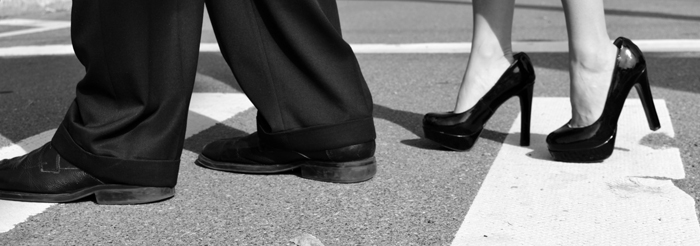
Image by Amanda Kirschenbaum
The physical and social implications of women’s shoes
What role should high heels hold in a professional working environment? This question — and the shoes themselves — stir controversy among women who aim to present themselves as professionals and equals while still maintaining comfort and free will. Even the feminist movement is divided on the issue; some argue that heels boost a woman’s poise and confidence, while others feel that the shoes represent a double-standard in self-presentation that puts female workers at a disadvantage.
While heels aren’t required in every professional workplace, many women still feel compelled to wear them in order to maintain a polished image. Caryanne Keenan, assistant director for career development at Ithaca College, explained that this once-standard notion of professionalism is changing.
“That visual of the businesswoman with the heels is definitely more professional-looking, according to our standards in this country,” she said. “That is a little more old-school, but some places are becoming a little more human-friendly, to realize that that’s the most uncomfortable thing in the world to wear all the time. Like at banks, I’ve noticed it’s more common for women even if they are wearing a suit to wear professional-looking flats, that’s become more acceptable.”
Keenan is of the opinion that the heels are an indicator of the ongoing struggle for equality in a male-dominated workplace.
“It’s bad for your back, it’s bad for your posture … but that visual of the businesswoman with the heels is definitely more professional-looking, according to our standards in this country,” she said. “It makes women look taller and thins out their legs. The taller aspect is a little surprising, because it [actually] makes us closer to men. The making [us] look thinner, I’d imagine is a westernized idea, because in our culture women are forced into this image of what men want us to look like. The heels are a part of that.”
While employers have the right to set standards of professionalism for their employees’ self-presentation, wearing high heels should be a personal choice, rather than an expectation. The modern concept of “professionalism” has been shaped over centuries by our culture, and since equality in the workforce is a relatively recent movement, the culture is continuing to evolve. As a result, we should question our expectations when they start to seem detrimental or impractical.
Women who feel more confident tackling the working world in heels should be able to do so, but learning how to teeter-totter around in impractical shoes should not make a woman any more qualified for the work environment unless she’s a runway model.
____________________________________
Karen Muller is a junior IMC major who thinks you could learn a lot if you walked a mile in her stilettos. Email her at kmuller1@ithaca.edu.
